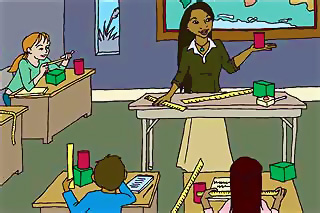What should Ms. Begay know about creating effective lesson plans?
Page 16: Lesson Plan Design
 The daily lesson plan is the most detailed standards-based plan that a teacher will develop. It outlines the purpose and activities of what will be done on a specific day or across several days. Unit plans help to turn year-long plans into daily plans. Standards-based daily lesson plans are composed of objectives and activities that are based on the unit plans. The standards-based daily lesson plan allows the teacher to make academic learning relevant to students by intertwining content knowledge, information-processing skills, and life experiences. The daily lesson plan includes the following components:
The daily lesson plan is the most detailed standards-based plan that a teacher will develop. It outlines the purpose and activities of what will be done on a specific day or across several days. Unit plans help to turn year-long plans into daily plans. Standards-based daily lesson plans are composed of objectives and activities that are based on the unit plans. The standards-based daily lesson plan allows the teacher to make academic learning relevant to students by intertwining content knowledge, information-processing skills, and life experiences. The daily lesson plan includes the following components:- Lesson Information
The teacher begins to plan each lesson by considering the students’ characteristics as well as the learning context. This consideration entails a deep understanding of what he or she is to teach (content standards, standards-based curriculum, and guidelines), what students should be able to do, and what performance will look like when instruction has been completed. Lesson information includes not only the content but also the learning and developmental needs of the students. The teacher must consider the time he or she has to complete the lesson and other resources available, and should decide whether or not the lesson should take one class period or several. Questions to ask include:- Am I planning the right amount of activities for the time I have?
- Is the scope of the lesson too ambitious for the time allotted?
- Will students be able to stay on task, or will they become disengaged because they’re spending too much time on one small aspect of work?
Success in the lesson depends on how appropriate the focus, time frame, activities, and assessments are for the students. It also depends on the skill with which the teacher is able to match instructional strategies to student learning needs.
- Lesson Topic
The lesson should begin with a topic derived from the adopted standards-based curriculum for a school or district. Because it relates to specific information the teacher is trying to impart, the topic should be part of the larger curriculum (such as unit instruction) required at your grade level. However, the specific topic for the lesson may emerge from student questions or interests (e.g., a lesson about the environment or space exploration), from community resources (e.g., the Rio Grande River, Manzano Mountains, Carlsbad Caverns), from local expectations included in the content standards (e.g., cattle ranching, New Mexico water rights, the connection between language and culture), and other topics listed in the standards (e.g., data analysis, geometry, life science).
- Benchmarks and Performance Standards
Decide on the benchmarks and performance standards you will address during the lesson. These may come from one content area or integrate standards and benchmarks from several content areas. Remember to consider how much time you have for the lesson.
-
Intended learning outcomes
“When first planning for instruction, teachers frequently focus on the selection of content, teaching method, and instructional materials. These are all important elements of instructional planning, but the entire process is more effective if attention is first directed toward instructional objectives” (Gronlund, 2004, p. 3).Intended learning outcomes:
- Are tied specifically to the standards or benchmarks addressed in the lesson.
- Clarify intended learning outcomes for both the teacher and the student
- Provide a focus for instructional planning
- Set the stage for teaching, learning, and assessment
- Identify specifically how learning will be evidenced
In the lesson plan, state your intended learning outcomes using the following language:
- By the end of the lesson, students will be able to… (e.g., recognize the leaves of piñon, aspen, and juniper trees; create a timeline of nineteenth-century New Mexico.)
Clarify the intended learning outcomes for students by writing them on the board or through some other visual format.
-
Instructional Resources
In your planning, carefully consider the resources that will support student learning during the lesson.These might include:
- Textbook or other reading materials
- Websites
- Word processors or other specific computer software
- Movies, CDs, of other media
- Guest speakers
- Project supplies, including posters, paper, markers, or tape
-
Arrangement of the Environment
Arranging the environment is a decision closely related to the ways in which students will complete components of the lesson.Questions to consider:
- Will students work in cooperative groups or independently?
- Will several activities take place during the lesson or require more than one desk arrangement? How will transition between activities take place?
- Will students move among learning centers that are set up in the classroom?
- What arrangement will best support movement among these centers?
- Will accommodations for special needs students need to be made to support movement among centers or any other activities?
- Will students need to focus attention on a screen or guest speaker at one point in the room?
- Where will supplies be located for easy access?
- Instructional Activities
A good daily lesson plan will include at least the following:- Introduction
The beginning of the lesson should engage the students’ attention and focus on the topic. Remember, activities should be based on the standards-based curriculum. Activities might include a challenging question, a quick survey of attitudes or beliefs about the topic, or a movie clip or other short media device to stimulate discussion. Reviewing what the students know or have previously experienced is key to the activity and would be an appropriate introduction, as well. - Lesson development
Teachers should make students aware of the intended learning outcomes of the lesson. Your description of each activity should include a discussion of what you will do as the teacher and what the students will do, as well. It is important for students to employ higher order thinking skills so they may apply and synthesize new content. Explain what modifications will be made for special needs students. Remember that the time frame you have established for this lesson. How long will each activity take to complete? How many activities can students realistically engage in during the time allotted? - Assessment activities
During the lesson, you should monitor student learning. Describe specifically and in measurable terms how you will determine whether students have met the intended learning outcomes. For example, your description of the assessment process might include statements such as the following:-
- All students will actively participate in each activity.
- All students will complete a timeline that includes the important events discussed during the lesson.
- All students will write a statement at the end of the class about what they learned during the lesson.
-
- Wrap up:
End class with a restatement of the intended learning outcomes. Decide on a way to close the activities. Will students reflect on what they have learned? Will they turn in their work or complete it as homework? Have you clearly defined expectations for their homework assignment (if applicable)? Does the homework assignment extend or complete the intended learning outcome?
- Teacher Reflection
When you have actually taught each lesson, write a reflection on what occurred during the process. Did students meet the intended learning outcomes of the lesson? Why or why not? Consider your part in their success. Was the timeframe appropriate? Were your directions clear? Did the activities you planned actually support the intended learning outcomes or were they somehow off-track? Were activities adequately modified for special needs learners in your class? What activities would you do again? What would you do differently next time?
- Introduction
It is important to recognize and incorporate students’ cultural and linguistic differences while developing standards-based lessons. Listen as kindergarten teacher Veronica Nolan explains how she includes her students’ culture into her classroom activities (time: 1:35).

Transcript: Veronica Nolan
It’s such a strength to be able to individualize and bring what is at home into the classroom, and I think that’s been my success in my 19 years of teaching. I have been blessed with a lot of families that have diverse cultures and have asked them to bring that into the classroom, and there’s some examples I could give, but it’s been like a world of travel for me. I’ve not been able to physically get to their home country, but by them bringing it into the classroom I feel like I’ve been there. For example, last year I had a family that came from India, and they were going to go to India for two months, and I said, well, you know, if it’s, “I don’t mean any disrespect, but I’m really am interested in your culture, and if you can bring anything like children’s instruments or children’s books.” So they came back from India with tons of books for children, instruments. They even brought samples of food for the children and some of the spices that they did. And so they came in and talked about that. The mother came in and taught us to count the calendar numbers from 1 to 31 in her language, and she, by allowing that to happen, she ended up working in the classroom on a consistent basis weekly. And my students got to experience that, and so when they knew that Ochet was going to go back to India, they would get all excited for him because he was going to see his family, and he and we emailed. They kept in touch by email, too, with some of the students, and I kept in touch with email with Ochet’s family. So it was really…it was just so interesting, you know, to have that interaction between the cultures.
Activity
Write a standards-based lesson plan that includes the elements described in this module. You should include at least the following:
- Lesson information: content area, grade level of target group of students, and timeframe of the lesson
- Lesson topic
- Standards, benchmarks, or performance standards addressed in the lesson
- Intended learning outcomes for students
- Instructional resources
- Arrangement of environment (e.g., independent seat work, cooperative groups, work on projects or presentations, specific modifications)
- Instructional activities:
- Introduction to lesson
- Lesson development (be sure to include lesson adaptations for students with special needs)
- Assessment activities (be sure to include adaptations for students with special needs)
- Wrap up
- Teacher reflection